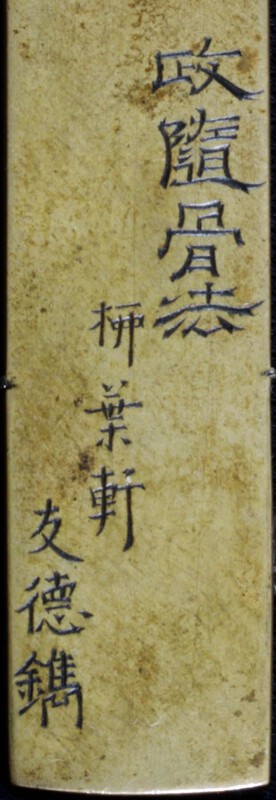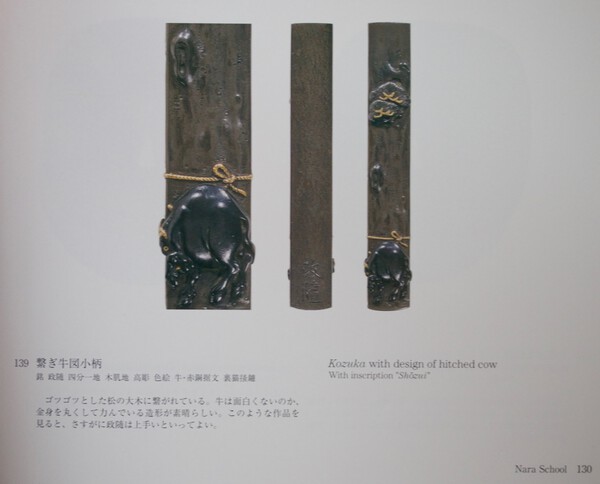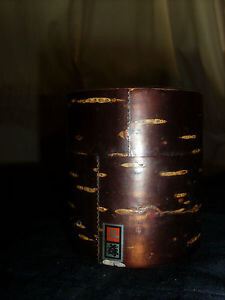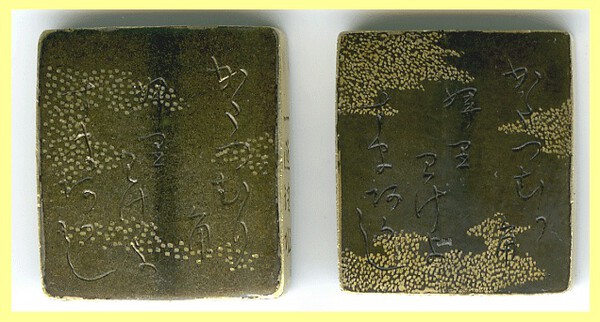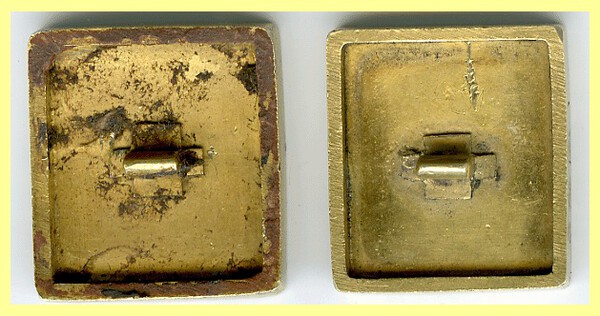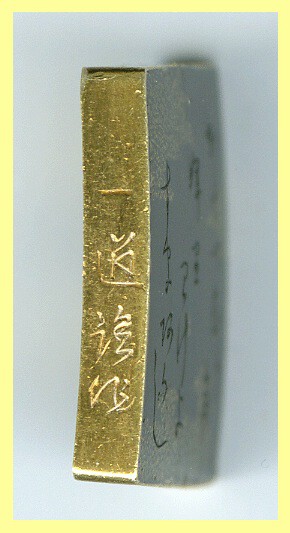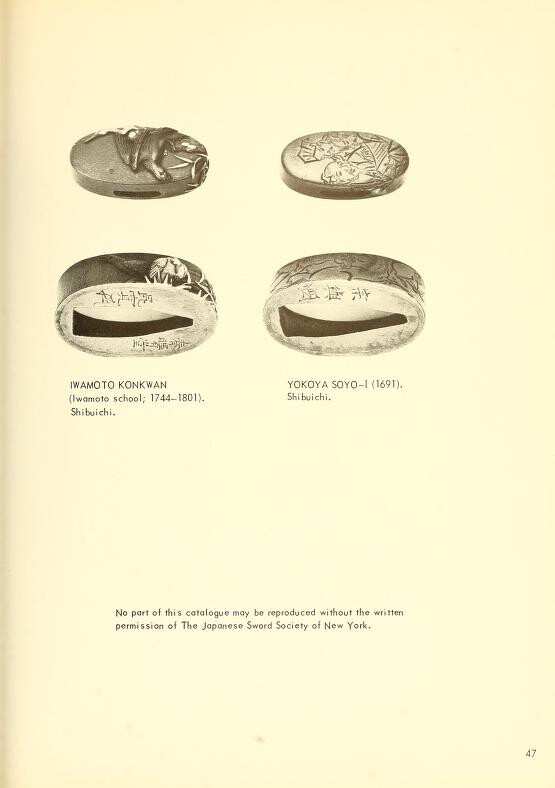-
Posts
858 -
Joined
-
Last visited
-
Days Won
7
Everything posted by Tanto54
-
Heavy Takabori Kozuka with deep purple black Shakudo. For an interesting translation exercise, I've included the signature... Picture of identical Kozuka from the Fukui Book.
-
bump
-
Dear Pietro, OK, let's try another analogy (for a guy who supposedly owns an Ichimonji, you've got me worried...). Let's pretend that Italy has a great Football (soccer) team this year (you have to pretend because they haven't won since 2006... I using sports because maybe you are more passionate about that than Nihonto). What if the Germans (an arguably richer country) offer all the Italian players thousands of dollars more to play for the German team? I imagine that many would turn the economically superior offer down because of certain intangible aspects. I also imagine that any of the beloved Italian players who did take the offer would be despised by many Itanians. I believe that some Japanese dealers and many non-Japanese Nihonto enthusiasts value similar intangibles in their Nihonto studies and dealings (and I'm not talking about simple xenophobia or nationalistic pride....). I hope that you will stop for a moment and consider some of the insight offered by others (e.g., Darcy, Curran, Guido, etc.)
-
Dear Pietro, No offense intended, but perhaps an analogy would help you understand. What if two guys wanted to marry your daughter... One is rich and throws a lot of money around but doesn't appear to know much about relationships. The other is not rich, but he's sincere and is obviously trying to have a great relationship with her. Who do you want to marry your daughter? My swords are like my daughters (you'll need to learn a lot more about relationships before I ever let you near one of them...)
-

Your Own Buyer In Japan
Tanto54 replied to Japan auctions's topic in Auctions and Online Sales or Sellers
Bottom of his emails -
Dear James, There are literally thousands of dragon menuki in this same general configuration. At first, many of them may look the same to you, but on closer inspection, you'll begin to see many subtle differences. Usually the quality of the fittings on a sword are fairly consistent across the pieces. On your sword (in my opinion) I believe that the menuki are better than the other fittings, but I would agree with Jason that they are not higher level.
-
Dear Mark, This is a Hannya Mask from the Noh Theater representing a female demon. Look up Hannya on the internet and you will find lots of information and several of the stories (the best, in my opinion, is about a woman who becomes very jealous and transforms into a demon incinerating the guy who made her jealous who is hiding under a big metal bell - this is why you often see a serpent with this face coiled around a bell in Japanese sword fittings).
-

Year End Fund Raiser/raffle/etc
Tanto54 replied to Brian's topic in General Nihonto Related Discussion
I'll donate some kodogu. -
Dear Steve, For hundreds of years, the Japanese have followed a calendar system that includes the Junishi (12 Zodiac Animals). Japanese often identified themselves with the animal from the year that they were born. Each of the Junishi have certain attributes and traits (and combine better or worse with certain other Junishi - so this is often considered for marriage or whether a samurai is appropriate for a certain position or job). One of the Junishi is an ox/cow. In some cases, a samurai would choose tosogu based on their Junishi sign. However, of course, that doesn't mean that all oxen/cows are referring to a birth year, but when all of the tosogu are related to the same Junishi, that's usually a good assumption (in this case, with just the tsuba, its impossible to tell). By the way, the Junishi are: rat, ox, tiger, rabbit, dragon, snake, horse, goat, monkey, rooster, dog, and wild boar.
-
Dear Bob, The menuki are Sode (Samurai Armor Shoulder Guards).
-
Dear Ron, I cannot tell for sure from the pictures (need more detailed pictures or to see it in hand), but I saw a saya like this about 40 years ago that was made from cherry bark veneer bands that were "sewn" together, sanded down and then lacquered over. It looked almost exactly like the one in your pictures (but I'm not saying that this one is cherry - perhaps another bark or wood veneer). I've attached a picture of a tea caddie that is made the same way (sorry it's not a more detailed picture - it's the best that I could find on the Internet). If you look carefully, you can see the same "long/short" stitch pattern that is on the saya going vertically up the side of the tea caddie. I've also attached a picture of another Japanese box that shows the stitching technique more clearly (and much larger). When you get it in hand, see if you think it could be this technique.
-
modern replica
-
Hi Grey, Yes, typo should have been Yotsuwari (fixed above).
-
Dear Grey, I think: Owari Raimon Yotsuwari Hishi Sukashi translated to Owari [tsuba] with Kaminari (thunder) crest, four sided/divided (perhaps it has a diamond shape that is divided into 4 parts) & pierced
-

How Were Tsuba, Menuki, And Fuchi Kashira Chosen?
Tanto54 replied to general_piffle's topic in Nihonto
Following up on and augmenting what others have said, I'm surprised to hear that anyone with much experience with sword fittings would say that having a theme running across the fittings (i.e., either a common look, matched set, motif, legend or thematic allusion, related articles - like tea ceremony tools, etc.) on a good sword was unusual. I've always been taught and understood that having such a “theme” was the standard instead of the exception and anyone with basic sword fittings knowledge understood this. I have rarely seen a decent sword (i.e., one that has been "outfitted" - not talking about mass produced junk) that was outfitted at least 150 years ago (using this to screen out tourist and Western outfitting) that did not have such a theme across the fittings. For good swords, I'd say the percentage without any theme would be less than 20% (and some of those are probably just themes that we didn't recognize). So how can we explain Ken’s friend? (no offense intended) How could a Japanese from a Samurai family who collects swords not understand this basic fact? I see this in Japan all the time with many of the different Japanese arts (and with my wife who is a Japanese artist...). Modern Japanese know very little about the legends, myths and motifs that are on ancient Japanese art, and quite often, it is the Westerner, who studies their legends, mythology and folktales, that can spot the theme. Do any of the experts here really disagree? -
One of my favorite gold menuki (not mine, posted from Fred Weissberg of nihonto.com with his permission). "Solid" gold covered with a thin overlay and then carved through with a poem and mist (e.g., poem cards - Uta Garuta). Very elegant in my opinion.
-
Dear Ford, I believe that a very close look at the Yokoya School could help you pin down a start date. The picture below is from "The Japanese sword and its fittings, from the collections of the members of the Japanese Sword Society of New York and the Cooper Union Museum ... [exhibition] catalogue, Mar. 25-May 28, 1966". The Fuchigashira does appear to be shibuichi and is signed Yoko Soyo and attributed to the Shodai (died 1686-1691 depending upon the reference, but here it says 1691). I can't see the signature very well, but I personally think that it may be a later Soyo.
-
Dear Richard, Found this Tsuba on Aoi-Art with the same symbol but without the hitsu-ana (the Bonji idea was creative, but probably not correct). Unfortunately, Aoi didn't know what it was either…. http://www.aoijapan.com/a-set-of-5-tsubas
-
His work is excellent - this tanto went for almost $10K….
-
Hi Peter, Too faded but maybe 軍医 ??大野康雄 (gun i ?? Oono Yasuo = Medical Doctor ?? Yasuo [first name] Oono [last name]).
-
Can you show us the other menuki and fittings? It may help in determining the subject. It does look like a mailman collecting letters… However, many antique Japanese boilers/stoves have arabic numerals, so a stove or boiler may make sense (perhaps a steam locomotive firebox?)
-
It is interesting that we all love swords, but many of us do not seem to know how they are used. The tsuba is not intended for blocking or catching an opponent’s sword. If it were, it probably would be shaped more like the hook (kagi) on a jutte or sai. Instead, a tsuba’s main purpose is to keep its owner’s hands from sliding forward onto the blade (and to balance the sword). Think about it, what are the chances that you could “catch” your opponent’s strike with the 1.5 inch radius of a tsuba or, with the way swords “rebound” when hitting each other, that the opponents blade would slide neatly down your sword and stop right on top of your tsuba? That’s why you don’t see many tsuba with kiri-komi (cut marks). This is also why it doesn’t matter that tsuba are often made of soft metals (shakudo, shichu, etc.). We shouldn’t be too hard on ourselves if we had this misconception about tsuba because even one of the directors at the NTHK-NPO (who is often cited as a sword expert) is clueless on this point. He actually declared that soft metal tsuba were not intended for real battle use because they might be cut through when blocking any opponent’s sword (despite the fact that there are literally hundreds of thousands of such tsuba in existence and even some very early swords had soft metal tsuba and many are from the waring periods). On the extremely rare occasion that the opponent’s strike might slide down your sword and stop against your tsuba, it has become a glancing blow with little force and can easily be stopped by a soft metal tsuba. But what about leather or wood covered tsuba? We see similar “soft core” armor items (e.g., helmets, torso and thigh protectors, etc.) that are made from leather covered with lacquer. Some of the more decorative armor items were made this way during times of peace or for weight considerations for Samurai that did not intend to use them in battle; however, many that were made this way were intended for, and used in, battle. Change out Tameshigiri mats with lacquer covered leather with silk bindings and you will probably see a much larger percentage of cutting fails... I also believe that a blocked sword sliding down the blocker’s sword would probably not cut through lacquer covered leather (remember the reports of Samurai returning from the Korean campaigns with many of their swords broken by Korean leather armor?). While I would strongly prefer a metal tsuba in battle, I could also believe that some of the lacquered leather and wood tsuba may have been used for more than decorative purposes.
-
Dear Fleck, pretty sure the menuki is a dragon.
-
I'll take the Hartman Collection.



